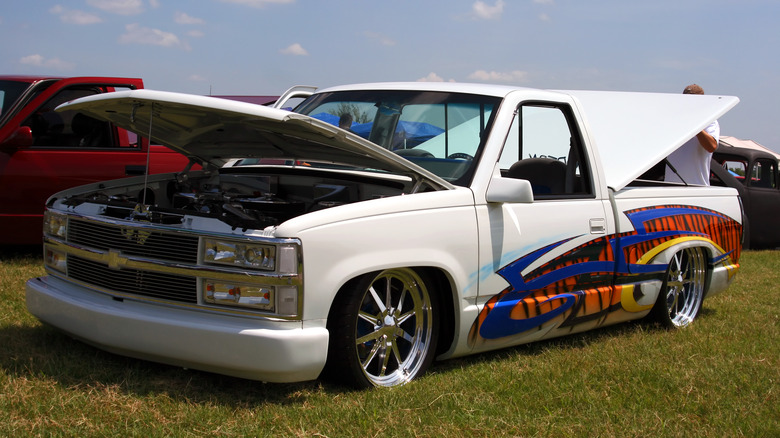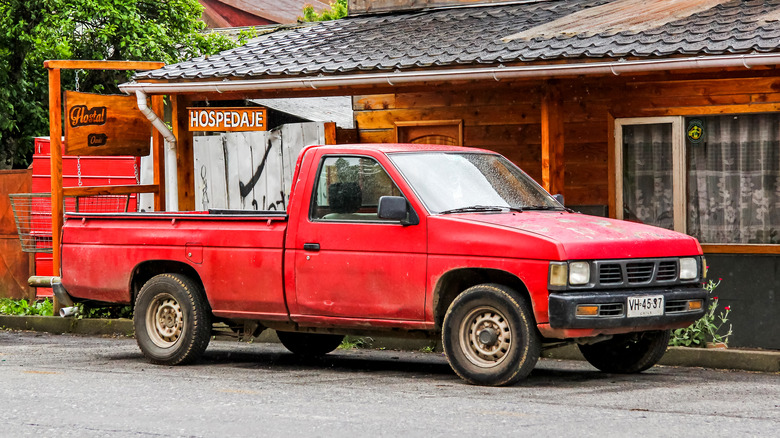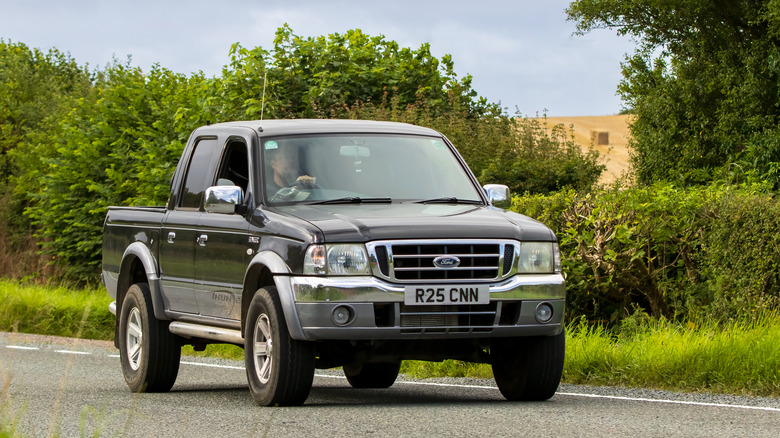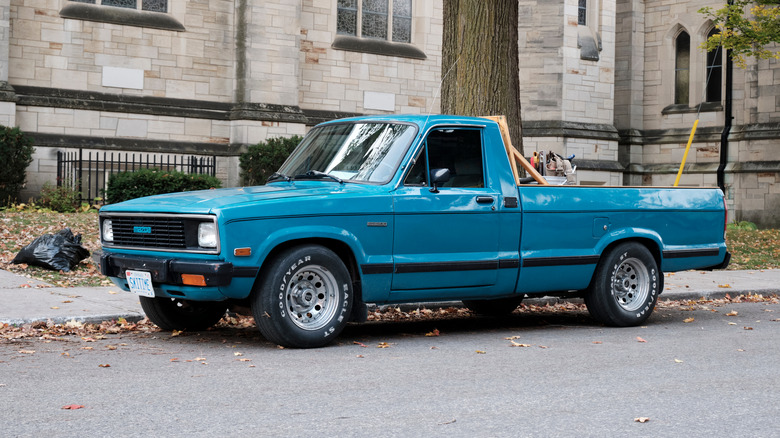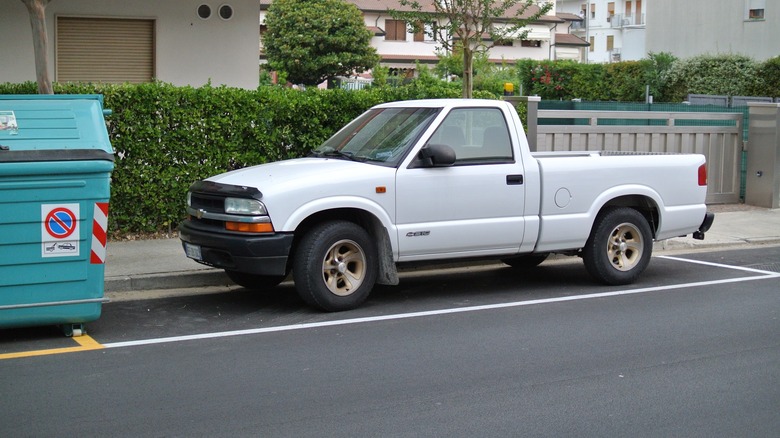5 Mini Trucks That That Are Perfect For Modifying
Mini trucks are more than just small pickups ever since they became a favorite among car fans, who love to tweak and transform them. Since the 1980s, these trucks have been popular for their cool looks and the fun of making them unique. Enthusiasts modify these trucks into various styles, from sports trucks to pro-touring trucks. But one of the top trends is making these trucks lower to the ground — typically called slammed or mini trucks.
Getting a truck to sit low involves a few tricks. To achieve this look, modifiers often use techniques like air-bagged suspensions or body drops (also known as channeling in hot rod circles), where the body's floors are cut to allow the vehicle to sit lower, sometimes even touching the pavement. Some trucks are better for a project like this than others, and there are pickup trucks that have great track records of being modified, too. In any case, in this article, we'll be looking at which mini trucks are perfect for modifying.
Toyota Tacoma
The Tacoma, first seen in 1995, is a standout truck known for its toughness. Fast forward to 2024, the Toyota Tacoma has grown into its fourth generation. Over the years, the truck has grown bigger to the point that it's a midsize truck now, but the first-gen Tacoma remains a popular choice for enthusiasts who want to modify it into a mini truck.
The first-gen Tacoma kept the strong frame of the older Toyota trucks but added some nice touches. It was light and tough, perfect for off-road fun. The Tacoma's engine lineup was also impressive. The options ranged from a 2.4-liter, four-cylinder engine on 2WD models to a more powerful 3.4-liter V6. Both engine types and the four-speed and manual transmissions had exceptional reliability. This made the Tacoma a dependable ride, whether you were driving in the city or heading off-road.
Of course, for some, the true charm of the first-generation Tacoma lies in its potential for modifications, particularly as a lowered mini truck. Its strong build and reliable engines make it great for customizing — lowered suspensions, chrome rims, and cambered wheels. Thanks to being a Toyota, the Tacoma benefits from many extra parts being available, too, so you can make it your own. According to some owners, there are a few things to watch out for. Some find the seats a bit uncomfortable. Also, the truck's frame can rust when exposed to snow or salt. So, remembering these is good if you're considering getting one.
Nissan Hardbody
The Nissan Hardbody, arguably one of the 15 most reliable pickup trucks of all time, is also a classic mini-truck loved by many. Making its debut in the mid-'80s, the Hardbody, also sometimes known as the D21, introduced a more rugged, double-walled bed and a distinctive straight body line running the length of the truck. Interestingly, the Hardbody has roots in the Datsun era, when the company transitioned from Datsun to Nissan branding, resulting in this iconic model. Unfortunately, Hardbody's tenure extended from 1986 to 1997, but it's still a great option for a custom project.
So, why do people like to modify the Hardbody anyway? Because it's simple and tough. This makes it easy to change and add new things. The truck's 2.4-liter KA24E engine is the same as in the 240SX car, so finding parts isn't hard either. For example, enthusiasts like James White spoke to Street Trucks and demonstrated the truck's potential, retrofitting it with modern amenities such as updated interior elements, custom paint jobs, and improved suspension systems like air springs.
But changing a Hardbody isn't always easy. Given its age, finding a Hardbody in good condition can be a task. But once acquired, the truck's simplicity and robustness should make it a joy to work on. The ease of swapping parts, coupled with a wide selection of aftermarket components and the fact that parts from different Hardbodies can be interchanged, means this is one mini-truck you can customize to your heart's desire.
Ford Ranger
The Ford Ranger, especially the ones made from 1998 to 2011, is another great choice for anyone looking to modify a small truck. These trucks are smaller than the newer models, making them perfect for this kind of project. They are known for being reliable and easy to drive, too, which is a big plus.
One of the third-gen Ranger's strengths lies in its engine variety, including the durable and fuel-efficient Duratec 2.3-liter inline-four and the mighty 4.0-liter Cologne V6. The latter, especially in its high-output SOHC form, is both powerful and efficient — a good candidate if you're looking for a performance-focused mini truck. Also, the availability of manual and automatic transmissions means that you can customize them based on your driving preferences.
Third-gen Rangers are also usually the best out of all the models for modifying into a slammed mini truck, and it involves various adjustments. Lowering kits, custom suspension setups, and aftermarket parts are readily available, thanks to the Ranger being quite popular. With this kind of truck, you can also go from simple cosmetic changes, like custom bumpers and lighting, to more intricate engine tuning and suspension overhauls for better performance.
However, it's important to remember that these trucks are not new. They might need some work, like changing engine belts or fixing other old parts. Also, there were some recalls on these models for things like airbags and fuel systems. It's a good idea to check these out and fix them if needed.
Mazda B-series
The Mazda B-Series is another great mini truck that holds its own when it comes to customizing. Back in the '80s and '90s, it was just a simple, everyday truck. But now, it's become something people like to use as a project base. This is most likely because the Mazda has a neat look that's easy to work with for mods — it's got clean lines and a simple design that's like a blank canvas for truck lovers.
From a performance perspective, the B-Series has evolved significantly over its production run. Early models like the 1988 B2200, while modest in power with their carbureted SOHC 2.2-liter inline-four engines, still provided a lot of utility and fuel economy. Later generations, particularly those post-1998, offered more powerful engine options, including 2.5-liter four-cylinders and heftier 3.0 and 4.0-liter V6s. These later models are a strong foundation for performance-oriented modifications, but the B-series models after 1994 are considerably larger and won't really qualify as mini trucks.
One big plus of the B-Series is that it's reliable, especially the models with two-wheel drive. This is important because you want a strong base for your custom work. You can do a lot with these trucks, too, like changing the suspension or adding cool body parts. But, as always, watch out for some issues — there are some reports that the four-wheel-drive versions can have problems with a part that controls the drive mode.
Chevrolet S-10
The Chevrolet S-10 is a truck that's been around since 1981 and is famous for being one of the first small trucks designed by an American company. In our opinion, it's also one of the five trucks Chevrolet should have never discontinued. Over the years, it's had a few different looks, but one of its best versions came out in the 1990s. This model looked smoother, which people liked.
What's cool about the S-10 is that you can do a lot to change it up — especially in its second generation (1994-2004). The truck's frame and suspension lend themselves well to lowering modifications, creating a "slammed" look popular in the mini truck scene. The S-10 is easy to work on, based on the many modified Chevy S10s out there, which is great for people who love to tinker with their trucks.
This truck comes with a couple of different engines. The smaller one has a 2.2-liter engine, and the bigger one has a 4.3-liter one. The bigger engine is obviously stronger, but the smaller one does not lag too far behind — for a truck project that's largely about aesthetics, either option will likely work for you.
Modifying an S-10 can have its challenges, too. Since it's an older truck, finding the right parts might be tough sometimes — you might have to deal with rust or other wear and tear and also upgrade the engine, but then again, that's what modifying is all about.
